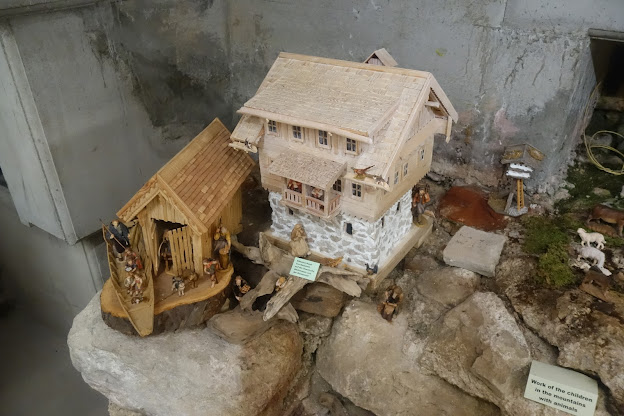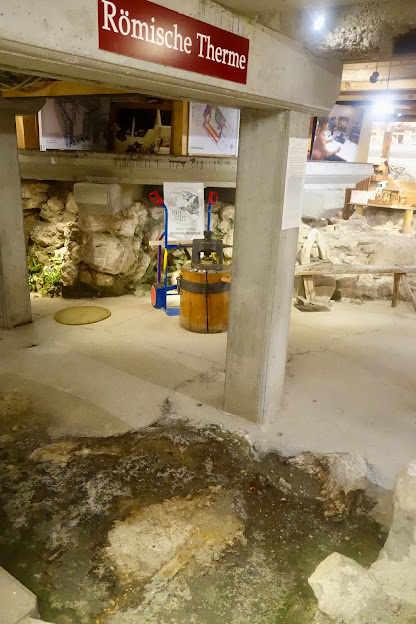Hallstatt, 14th of June 2020
Walking through Hallstatt on a rainy Sunday mid of June 2020 it was just by chance to see an indicator on one of the walls of a sports shop. It was said that the archaeological site in the cellar of the shop can be visited free of charge during the open hours. So, I entered and stepped down on the ancient stairs from stone.
I was already tired and I shot only some superficial pictures of it, but I am sure I will come here again in autumn maybe.
Anyway, there is no connection text-pictures, the pictures are just aleatorily chosen.
The text below is the original text you got from the owners of the building in form of printed sheets.
During the installation of a boiler room in 1987 we discovered extensive finds in the house's cellar. The cellar was excavated over a period of eight years by the Federal Ministry for the Preservation of Ancient Buildings and Monuments in Vienna and is for all to see today.
The periods of history in our cellar range from the New Age and for into prehistory. Ball-headed needles from the Bronze Age, shards of large Celtic containers, and the walls of Roman fortifications gove is a sweeping survey of ancient history. The Middle Ages are evident with the walls of the Hofburg, together with the giant square stone blocks of the watercourses. We can discern the site of the salt mine forge through individual installations. There are now constantly changing exhibitions in our cellar.
Ball-headed Needles from the Hallstatt Period - 1000 BC
Money in the form of coin was still unknown. The salt barons displayed their wealth in sumptuous gold and bronze jewellery, bronze containers, ceramics with a glowing metallic graphite finish. All that the world then had to offer in what was precious and sumptuous came to Hallstatt. It was with the jewellery and weapons that was mostly traded over great distances, which gives us an idea of the great mobility of people of that time.
Ceramic Shards from large Celtic containers
The people who had become rich during the Hallstatt Period were hardly able to offer resistance to the warlike Celts. They were driven off by the new rulers. The Celts also became a great people and had rich jewellery in their high culture, including beautiful container forms in bronze and ceramics. They loved great festivities and used large ceramic vessels for drinking, as seen in the finds from our cellar. Through trade with Greece, the Celts learned of the use of the potter's wheel for making their ceramics.
Walls of the Roman fortifications
The peaceful change came about when the kingdom of Noricum became a Roman province around the birth of Christ. Thus the Romans also settled in Hallstatt, and it is to be assumed that they continued to mine for salt using the subdued Celts. This is shown by settlement remains from various parts of the town. These massive remains of the Roman walls are to be seen in our cellar - fortifications connected to the administration of salt mining. Hypocausticized bricks, numerous pieces of broken pottery (terra sigilata, grey-clay wares), fibula and Roman coins.
Vespanianus coin, AD 78-79
Antonius IV coin, AD 218-222
The Walls of the Habsburg Court
Massive stone blocks show this to have been a representative building from the salt mining period of the Habsburg's at the beginning of the 14th century. From the body of finds - sumptuous tiles, painted furniture, parts of a fallen ceiling, bull's eye window panes, and carbonised window frames - one can see that this was a luxurious part of the Habsburg residence, the Hofburg. There is no clear information concerning the completion of the building.
The Wood Store
An old engraving shows that a wood store for the pan house existed here between the 15th and 17th centuries. The pan house stood somewhat raised at the foot of the Hallberg. The place is known as the Pan House Hill today. The space in front of the boiling house served as an intermediate storage and place for chopping of the wood for the pans. The timber was brought as logs from the immediate surroundings across the lake. Most of the timber storage was found on a peninsula. This peninsula sank together with the boathouses in an earthquake at 1808.
The Salt Administration Building: 1650-1750
In an old view of Hallstatt we see the old pan house, and a large, elongated building that is bounded by a tower of at least six storeys, and a church-like building, also with a tower. This building was the largest in Hallstatt in those days. The foundation is in soft alluvial soil. To give a foundation to the walls, heavy wooden sleepers were laid beneath them. These installations are still to be clearly seen today. The cobblestone paving is from this time. The fire of 750 destroyed the building and the archives kept there.
Salt Mine Forge
Because the brine-house operations were down in the valley, the necessary workshops had to be built there, and because there was no approach road into Hallstatt, and all goods had to be conveyed over the lake, it was necessary to manufacture the nine-to-twelve metre boiling pans on the spot. A forge was therefore built here "am Hof".
Despite the hazard of fire, and that sufficient water power was only available in the village, moving beyond the village area was never considered.
The wide spectrum of iron finds gives a good insight into the work, technology and production of an early New Age salt mine forge at the beginning of the industrial era.
Installations for heavy hammer mills, lathes, flues and chimney foundations were discovered from the newly-built forge of 1802.
The Watercourse - The Mühlbach watercourse
A part of the Mühlbach was diverted here to make use of its water power. It drove the waterwheel of the salt mine forge. The watercourse is maintained in its original condition.














Keine Kommentare:
Kommentar veröffentlichen